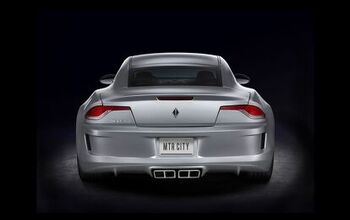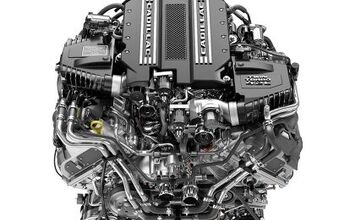Wither The Cadillac 2.8T V6?
When I attended the launch of the Buick Regal, Buick’s product reps were anxious to talk all about the forthcoming Buick Regal GS, the high-performance version of the Opel Insignia-based sedan. At the time, the Buick Boyz were anxious for input; what, they asked, would enthusiasts prefer: a manual transmission or all-wheel drive. My answer: all of the above. Surely, I thought, Buick would be bringing a rebadged version of the Opel Insignia OPC, with AWD and the GM 2.8T V6 from the Cadillac SRX Turbo and Saab 9-5 Aero. No, came the answer. The 2.8T was not approved for use in a Buick. Stung by past oversharing between divisions, GM had decided that the 260-325 HP, Australian-built LP9 engine would be limited to applications in Caddys and Saabs. But now, it seems that GM may have penned some kind of deal with Saab, as GMInsideNews reports that the LP9 has been discontinued from its last remaining Cadillac application, the SRX Turbo.
But GM is not yet admitting that its saving the 2.8T for Saab, as the GMI report cites a 90 percent take rate on the 3.0 version of the GM High-Feature V6 in the SRX. Which is interesting, given TTAC’s take on the 3.0 SRX was hardly enthusiastic, as Michael Karesh noted
The SRX’s standard 3.0-liter V6 kicks out 265 horsepower—at 6,950 RPM. The torque peak, where a much less impressive 223 foot-pounds reside, is a similarly lofty 5,100 RPM. Similar figures amazed the world two decades ago in the Acura NSX. And GM’s new 3.0 might have dazzled in a reworked Kappa sports car. But in a 4,200-pound SUV (4,400 with AWD) it’s out of its element. One gets the impression that GM had a much lower curb weight target for the new SRX (and a number of other recent vehicles), and then missed it by a few hundred pounds—not the sign of a well-functioning product development system.
But, the 2.8T had its own problems as well. Karesh’s assesment:
The 295-horsepower 2.8-liter turbocharged V6 accords itself fairly well in the SRX. Because of the mass it must propel this engine never feels especially strong, but unlike the 3.0 it never feels sluggish or strained, either. Only those paying very close attention will be aware that the engine is boosted. Throttle response isn’t as sharp as it is in the best naturally aspirated engines, and there’s some surging and lulling under light throttle, but boost lag isn’t readily evident. Neither is torque steer—the boosted engine is only available with all-wheel-drive. Fuel economy ranged from 16 MPG in moderately aggressive driving to nearly 20 in casual mixed driving.
The biggest problem with the turbocharged engine: it adds $3,820 to the SRX’s price yet provides only marginally competitive performance and fuel economy in return.
The lessons from GM’s decision to drop the 2.8T then, seem to be many. First, it seems that luxury CUV drivers would rather pay more for fuel economy than adequate performance. No huge surprise there. Second, offering two engines in the same model is a recipe for disaster unless the two engines are well differentiated in terms of either power or efficiency… otherwise, the more expensive engine will fall by the wayside. Third, now that Cadillac has dropped the 2.8T and GM doesn’t have to worry about cross-brand cannibalism, the decision to bring a four-cylinder Regal GS to the US market confirms that Buick will never become a true performance brand. Fourth, and finally, Saab may have exclusive access to a high-performance, premium engine, that hasn’t been able to tempt buyers out of a “torqueless” 3.0 V6 that performance enthusiasts are prone to comparing to “a boat anchor.” That’s not a great sign for a brand that has been struggling to find mass acceptance.
But Saab isn’t the only party facing a tough decision now: Cadillac needs to figure out if it wants to keep its SRX saddled to an underwhelming engine, or if it wants to add its widely-lauded 3.6 direct injection V6 (or possibly a rumored turbocharged version of same) to the SRX lineup. In reality though, the Buick LaCrosse’s shift to standard hybrid power probably tips Cadillac’s way forward. AutoWeek reports that a plug-in version of the SRX is in development, and Cadillac could well make the SRX’s optinoal engine a high-efficiency model rather than a high-performance one. That, apparently, is what the market seems to bee asking for.
More by Edward Niedermeyer
Latest Car Reviews
Read moreLatest Product Reviews
Read moreRecent Comments
- VoGhost I know one commenter who would love to live in Kia towers.
- VoGhost Matt, do us all a favor, will you? Since you love the term 'EV mandate' so much, could you please point to a single country or state that has mandated that consumers buy an EV? At any point in time - historical or the future. Just one, Matt. Just a single place where the term 'EV mandate' is even close to being true.
- VoGhost Just so we all have this correct, you're saying that the red states that refuse to educate their children or fund healthcare for their citizens also want them to die earlier from fossil fuel pollution? OK. I see. Makes the decision in November a little more stark.
- Golden2husky The image that sustainable products are second-rate is a problem that the industry has to overcome. Best way to do that is to make sure your first effort is a home run right out of the box. Michelin is the type of company that can make it happen.
- VoGhost At some point, is TTAC going to explain how Tesla doesn't have MSRPs or dealers or dealer incentives? That there's no cash on the hood, subsidized leases or other games that legacy ICE automakers play with consumers? Or is it just easier and more profitable for TTAC to just continue to make an article of every price fluctuation?


































Comments
Join the conversation
Buick’s target market could care less. What you mean is Buick's target market COULDN'T care less........
I can't believe that a Boosted GM motor has less power than a NA Ford. Granted the Ford has more displacement but even that seems backwards.